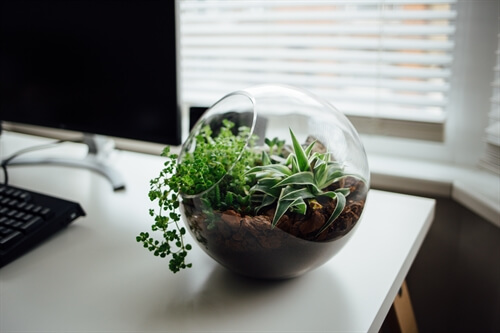Although terrariums are generally considered a low-maintenance kind of gardening, they do still need attention, and it’s very possible to get attached to your garden in a bottle, adding hard-to-find plants, and one-of-a-kind decorations. So when it comes to moving day, you’ll want to take good care of the terrarium that you’ve invested time and money in.
Open and closed terrariums have differing needs
There are two kinds of terrarium – open and closed. Each one has slightly different needs, and to keep them at their best, you’ll need to continue meeting those needs during and after the move.
In either case, think about where your terrarium will be during the move. Avoid leaving it anywhere where it will experience extremes of temperature, direct sunlight, frost or heavy rain such as a car or a garage. And watch out for helpers who put all plants, indoor or outdoor, in the garden.
Reduce stress during your move
Moving home is really, really hard, even if you have plenty of help and support. On moving day, things that you think you’ll prioritise – like your terrarium – may get forgotten. So anything you can do to manage your own wellbeing will benefit your terrarium.
How to pack a terrarium for your move
Most terrariums can be moved in one piece as long as you keep them upright. You may want to move it personally, rather than trusting it to removal staff. And try to pack your terrarium last, putting it near the door of your removal vehicle so it gets unpacked first.
For a very large terrarium, speak with a removals company that specialises in plants. If you think you’re going to have to dismantle your terrarium to move house, do it before moving day, as it will take longer than you think. Potting your plants up will keep their roots safe during the move. You can then replant them at your leisure when you arrive.
Read our general tips about moving house plants for more inspiration to help you plan your move with a terrarium. And if you think you’ll need some expert advice for replanting your terrarium, the RHS has a helpful video.
Make a date with your terrarium
Plan how you will care for your terrarium in the run-up and after your move. Many terrarium owners rely on a schedule to remind them to spend time checking and tending their plants. But these schedules can get thrown during a busy house move. Maintaining routines can really help with your wellbeing during a stressful time, so don’t neglect these small steps.
Can I keep a terrarium in my storage unit?
Storage units are not a good environment for living plant material, and most storage companies will have in their terms and conditions that you cannot store plants.
It’s best to keep your terrarium at home; and if you can’t, get a friend or a plant sitter to house it temporarily.
You can keep terrarium jars in your storage unit, tools, decorative bits and containers of dry substrate. Avoid storing anything damp or mossy, as it will not do well in a dark, climate-controlled environment.
As with any stored domestic equipment, your terrarium jars and tools will need to be covered by your self-storage insurance.




